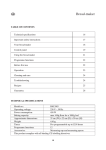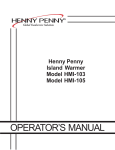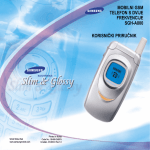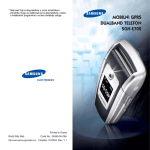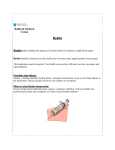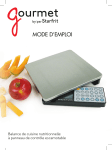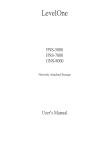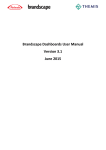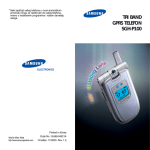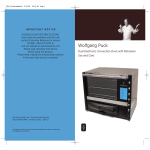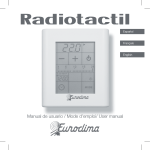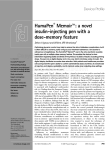Download Diabetes: An Owner`s Manual - NorthShore University HealthSystem
Transcript
Diabetes: An Owner’s Manual Your guide to successfully navigating your diabetes and living your best life. Northshore University HealthSystem (NorthShore) Diabetes Education Centers wish to express their gratitude to The Myra Rubenstein Weis Health Resource Center for its generous support of diabetes education initiatives. Diabetes: An Owner’s Manual, was generously underwritten by The Myra Rubenstein Weis Health Resource Center to help support diabetes patients and their families. Dear Patient: Welcome to NorthShore University HealthSystem (NorthShore), where excellence is all around you. Our outpatient programs in diabetes care are recognized by the American Diabetes Association (ADA), and our inpatient program at NorthShore Evanston Hospital achieved Advanced Certification in Inpatient Diabetes through The Joint Commission. At NorthShore, we are committed to helping you manage your diabetes through our comprehensive education and support programs. This booklet is designed to get you started with your diabetes care by providing important basic information while you’re hospitalized or in the outpatient setting. It also introduces you to our team of inpatient nurses and dietitians as well as our outpatient certified diabetes educators. These team members are specially trained experts in the field of diabetes and are available to provide an individualized treatment plan for you. Our educators also can assist you in planning for your diabetes care in the areas of diet, exercise, blood glucose monitoring and medication. If your doctor has requested that you test your blood sugar levels, our certified diabetes educators can provide you with a free blood glucose monitor and demonstrate how to use it. Use the following phone number for our outpatient Diabetes Education Centers if you have any questions or need to schedule appointments at any of our NorthShore Hospital locations: (847) 926-5032 •Evanston Hospital •Glenbrook Hospital •Highland Park Hospital •Skokie Hospital You may also access our program in Adult Endocrinology and Metabolic Diseases with a referral from your primary care physician. We are located at 9977 Woods Drive in Skokie, and can be reached by calling (847) 663-8540. We invite you to visit us online at northshore.org/diabetes for additional information and resources to help you take charge of your diabetes care. Inpatients can work with their healthcare team to assist with their diabetes education. Again, thank you for choosing NorthShore. You are an important member of the NorthShore Diabetes Care Team, and we’re here to assist you in managing your care so you can live a healthy, productive life. A Teaching Affiliate of the University of Chicago Pritzker School of Medicine Hospitals: i Evanston • Glenbrook • Highland Park • Skokie Helpful Information NorthShore Pharmacies Outpatient Diabetes Education Diabetes supplies are available at the following locations: Diabetes Education at (847) 926-5032 NorthShore Evanston Hospital 2650 N. Ridge Avenue Evanston, IL NorthShore Evanston Hospital (847) 570-2210 Outpatient Pharmacy 2650 N. Ridge Avenue Evanston, IL Diabetes Education at (847) 926-5032 NorthShore Glenbrook Hospital 2500 Pfingsten Road Glenview, IL NorthShore Glenbrook Hospital (847) 657-1785 Outpatient Pharmacy 2050 Pfingsten Avenue Glenview, IL NorthShore Highland Park Hospital Outpatient Pharmacy 777 Park Avenue West Highland Park, IL NorthShore Skokie Hospital Outpatient Pharmacy 9600 Gross Point Road Skokie, IL Diabetes Education at NorthShore Highland Park Hospital 777 Park Avenue West Highland Park, IL (847) 433-2508 (847) 926-5032 Diabetes Education at NorthShore Skokie Hospital (847) 926-5032 9600 Gross Point Road Skokie, IL (847) 933-6890 NorthShore Medical Group/ Endocrinology 9977 Woods Drive Skokie, IL (847) 663-8540 Here are other helpful diabetes websites: NorthShore University HealthSystem northshore.org/diabetes Academy of Nutrition and Dietetics eatright.org American Diabetes Association diabetes.org Juvenile Diabetes Research Foundation jdrf.org ii Diabetes: An Owner’s Manual Table of Contents Chapter 1 What Is Diabetes?...................................2 Chapter 6 Taking Insulin..........................................24 Causes and Symptoms..................................2 Insulin Pumps...............................................28 Type 1 Diabetes..............................................3 Chapter 7 Treating Hypoglycemia and Hyperglycemia...............................29 Type 2 Diabetes..............................................3 Pre-Diabetes..................................................4 Gestational Diabetes.......................................5 Chapter 8 Following Sick-Day Guidelines.........33 Chapter 2 Planning Healthy Meals.........................7 Chapter 9 Reducing Your Risk of Chronic Complications...................35 Food Groups..................................................7 Nutrition Labels..............................................9 Serving Sizes................................................10 Foot Care.....................................................35 Chapter 3 Getting Exercise and Physical Activity.....................................17 Eye Care......................................................36 Oral Health...................................................36 Chapter 10 Coping With Stress..............................37 Chapter 4 Monitoring Your Blood Glucose.......................................19 Chapter 11 Your Diabetes Care Checklist...........38 Chapter 5 Learning About Medications to Manage Diabetes.............................21 Chapter 12 Resources................................................39 Oral Medications..........................................22 Important Phone Numbers ..........................39 Injectable Medications..................................23 Safe Needle Disposal....................................40 Combination Medications.............................23 New “Apps” to Manage Diabetes.................42 1 Diabetes: An Owner’s Manual Chapter 1 What Is Diabetes? Diabetes mellitus, or diabetes, is a group of diseases characterized by high blood glucose levels. These high levels are the result of the body’s inability either to produce or to use insulin properly. “Insulin deficiency” means the body no longer makes insulin; “insulin resistance” means the body makes insulin but doesn’t use it properly. Here’s what happens: Every time you eat, your food is broken down into a variety of nutrients, including glucose (or sugar), which is used as fuel (or energy) in your cells for normal daily living. Glucose needs the help of the hormone insulin, which is made in the pancreas, in order to move from your bloodstream into your cells so it can be used as energy. The pancreas is a small organ located near the stomach. When you eat, your brain signals the pancreas to make insulin. Insulin acts like a key to unlock your cells so glucose can pass from your bloodstream into your cells. Insulin is important because it lowers your blood sugar and helps keep it within normal levels. Without insulin, glucose (or sugar) stays in your bloodstream and cannot get into your cells. This is what leads to high blood sugar readings. You may experience several signs or symptoms of diabetes, or you may not have any symptoms. Stomach Following are the classic symptoms: Liver •Frequent urination Pancreas •Thirst •Fatigue •Unusual weight loss •Frequent infections, such as urinary tract infections; yeast infections; or gum, skin and bladder infections Sugar Bloodstream • Blurred vision Sometimes, long-standing, undiagnosed diabetes can result in other symptoms such as: •Erectile dysfunction/impotence •Slow healing of cuts and sores •Numbness, tingling and burning of hands and feet Diabetes also may lead to a serious health condition called diabetic ketoacidosis, or DKA (see page 32). Without insulin, the cells of the body can’t get the energy that glucose provides. As a result, the cells use stored fat for energy instead. As fat is broken down, ketones are released into the bloodstream and eventually appear in the urine. 2 Diabetes: An Owner’s Manual What is Diabetes? Understanding Type 1 Diabetes Type 1 diabetes (formerly called “juvenile onset diabetes”) is usually diagnosed in children and young adults, although older adults may develop this disease as well. Only 5 to 10 percent of people with diabetes have type 1 diabetes, which occurs when the pancreas doesn’t produce insulin. With the help of insulin therapy and other treatments, even very young children can learn to manage their condition and live a long, healthy and happy life. Cell without diabetes Understanding Type 2 Diabetes Most people with diabetes—more than 90 percent—have type 2 diabetes, which also may occur at any age. In type 2 diabetes, the pancreas produces insulin, but either the body can’t use it properly (“insulin resistance”) or the body isn’t making enough insulin. Cell with diabetes Diabetes is a progressive disease, so over time, the pancreas will make less and less insulin and eventually will stop making enough insulin (“insulin deficiency”). The liver also may release stored glucose (glycogen) into the bloodstream at any time, causing your blood sugar to rise in the morning after an overnight fast. When any of these factors happen, glucose can build up in the bloodstream causing high blood sugar, or “hyperglycemia.” Following are characteristics of people at risk for developing type 2 diabetes: Glucose Receptor •Pre-diabetes (see page 4) Insulin •Sedentary lifestyle •Body mass index (BMI) of > 25 kg/m2 •Family history of diabetes •High triglycerides, or fat, in your blood •High blood pressure •Excessive alcohol consumption continued >> 3 Diabetes: An Owner’s Manual What is Diabetes? continued >> In addition, certain groups of people are at higher risk for type 2 diabetes, including: •African-Americans, Hispanic/Latino Americans, Asian Americans, Pacific Islanders, Native Americans and Native Alaskans •Women who have had gestational diabetes •Women who have given birth to a baby weighing more than nine pounds •Women with polycystic ovarian syndrome (PCOS) •Individuals with acanthosis nigricans, a darkening of skin that appears around the neck, elbows, underarms and knuckles If type 2 diabetes is not well controlled through a healthy diet, regular exercise and medications, it can lead to serious complications. Understanding Pre-Diabetes “Pre-diabetes” is a condition that occurs when blood glucose levels are higher than normal—but not yet high enough to be diagnosed as diabetes. Pre-diabetes also is called “impaired fasting glucose” or “impaired glucose tolerance.” People with pre-diabetes are at higher risk of developing type 2 diabetes than people with normal glucose levels. Research shows that some long-term damage to the body, especially the heart and circulatory system, may occur in people with pre-diabetes. Studies also show that the best way to control pre-diabetes is to control your weight by losing 7 to 10 percent of your total body weight and exercising regularly. Three blood tests can determine whether you have pre-diabetes, type 1 or type 2 diabetes. Blood Test What It Measures Without Diabetes With Pre-Diabetes With Diabetes (Type 1 or 2) Fasting plasma glucose > 126 mg/dL Blood sugar levels fasting > 8 hours < 100 mg/dL 100–125 mg/dL Oral glucose Blood sugar levels 2 hours < 140 mg/dL 140–199 mg/dL tolerance test after eating (often used to diagnose gestational diabetes) > 200 mg/dL A1C > 6.5 (estimated glucose number = 140 mg/dL) Average blood glucose over 2–3 months < 5.7 (average blood glucose range < 100 mg/dL) 4 5.7–6.4 (average blood glucose range = 117–137 mg/dL) Diabetes: An Owner’s Manual What is Diabetes? Understanding Gestational Diabetes Gestational diabetes is a common medical problem that usually occurs between the sixth and ninth month of pregnancy. During this time, the placental hormones in the mother’s blood increase her need for insulin. Insulin, the hormone produced by the pancreas, helps keep blood sugar within normal levels. When the body is unable to produce enough extra insulin or it’s not working effectively, high blood sugar, or gestational diabetes, develops. In most cases, the mother’s blood sugar returns to normal levels after the baby is born. However, women who have had gestational diabetes are at high risk—between a 35 to 60 percent chance—of developing type 2 diabetes within 10 years following the pregnancy. Gestational diabetes occurs in about 7 percent (7 out of 100) of all pregnancies. Most women with gestational diabetes have no symptoms, so a blood test is the only way to diagnose the condition. The test usually is performed at the end of the second or beginning of the third trimester (24–28 weeks). Women with the following risk factors may be tested earlier: •25 years of age or older •Being overweight (BMI > 25 kg/m2) before becoming pregnant •Having a family history of diabetes •Previously giving birth to a baby weighing more than 9 pounds •Belonging to a particular ethnic group, including African-Americans, Hispanic/Latino Americans, Asian Americans and Native Americans •Women with polycystic ovarian syndrome (PCOS) •Women with a prior history of gestational diabetes Untreated gestational diabetes can increase the risk of macrosomia (a baby weighing more than 9 pounds before birth), the most common complication for women with this condition. Babies of this weight may have problems during delivery, as well as breathing problems and low blood sugar levels after birth. Most women can control gestational diabetes with diet and exercise. Those who cannot keep their blood sugar within a normal range through diet and exercise alone may need to take medication. Your physician may refer you to an endocrinologist for follow up after the baby is born. continued >> 5 Diabetes: An Owner’s Manual What is Diabetes? continued >> Here are some tips to manage gestational diabetes: •Eat healthy and make appropriate food choices to provide good nutrition for you and your baby. Meet with a registered dietitian or certified diabetes educator to develop a meal plan during pregnancy and after delivery. •Monitor blood sugar levels as directed to make sure they’re within a normal range. A registered dietitian or certified diabetes educator can show you how to test blood sugar levels daily. •Get regular physical exercise, but check with your doctor first to learn the guidelines for safe exercise. •Check urine ketones each morning before breakfast to monitor adequate carbohydrate intake. Ketones are the result of the body using stored fat, instead of glucose, for energy. They’re released into the bloodstream and eventually appear in the urine. A registered dietitian or certified diabetes educator can show you how to test for ketones using a small plastic cup and Ketostix® strips, purchased at your local pharmacy. A1C Test The A1C test (glycated hemoglobin) measures a person’s average blood glucose level over the last two to three months. The A1C also can be reported as an estimated average glucose value (eAG). People with diabetes should get their A1C tested every 3-6 months. The table to the right shows the relationship between A1C and eAG: Average Amount of Glucose in Cells Non-diabetes A1C range: 4 – 6% Goal A1C: less than 7% High A1C: 7% or greater 6 A1C % eAG mg/dL 5 97 5.5 111 6 126 6.5 140 7 154 7.5 169 8 183 8.5 197 9 212 9.5 226 10 240 10.5 255 11 269 Diabetes: An Owner’s Manual Chapter 2 Planning Healthy Meals Planning for a healthy diet and choosing healthy foods that best meet your needs and eating habits are important steps in managing your diabetes. A balanced diet also helps you feel better. You can make a difference in controlling your blood sugar levels and reducing your risk for the complications of diabetes by eating the right kinds of foods at the right time in the right amount. Drinking alcohol also can affect your blood sugar levels, so be sure to talk with your doctor or certified diabetes educator to learn the risks of drinking alcohol when you have diabetes. Eat at the right time. Eat three meals a day spaced four to five hours apart at about the same time each day. This is especially important if you’re taking certain diabetes medications. Eat the right kinds of foods. There are three major nutrients in food: •Carbohydrates: Carbohydrates (or “carbs”) raise blood sugar. Choose whole grains, fruit, low-fat milk and vegetables every day. •Protein: Protein does not have a major effect on blood glucose. Choose lean beef, pork, chicken, fish, eggs/egg whites, reduced fat cheese and tofu. •Fat: Very little dietary fat turns to glucose, but certain types of fat can increase the risk of heart disease. Choose from at least three of the food groups, ideally incorporating a fruit and/or vegetable, at each meal. Healthy fats can be added in moderation. Fruit Milk/yogurt (1 serving) (1 serving) Starches (1/4 of a 9” plate) Vegetables (1/2 of a 9” plate) Meat/protein (1/4 of a 9” plate) 9” plate 7 continued >> Diabetes: An Owner’s Manual Planning Healthy Meals continued >> Eat the right amount of each nutrient type Carbohydrates provide energy, fiber, vitamins, minerals and antioxidants, so it’s important to eat reasonable amounts of carbohydrates at each meal. Here are some examples of one carbohydrate serving, which equals 15 grams of carbohydrate: 1 slice bread 1 small apple 1 cup milk 2 small cookies Carbohydrate foods include: •Starches (grains, cereal, starchy vegetables such as corn, peas and potatoes) •Fruits and fruit juices •Milk and yogurt •Desserts and sweets Nonstarchy vegetables have little effect on blood sugar and provide few calories. They can help lower blood pressure and cholesterol, and they have other health benefits—so incorporate more vegetables into your diet. Some examples of nonstarchy vegetables include green beans, broccoli, spinach and tomatoes. Talk to your certified diabetes educator about how many grams of carbohydrate per meal or snack (or how many servings of carbohydrate) you need to manage your diabetes. You also can learn about “carb” counting to keep track of how many carbohydrates you eat at each meal. 8 Diabetes: An Owner’s Manual Planning Healthy Meals Understanding Nutrition Facts Label 1. Start with Serving Size and Servings Per Container because the rest of the label is based on this information. Measure foods to determine how many servings you’re consuming. 2. If you’re watching your weight, look at Calories first. If you’re trying to maintain or lose weight, your meals should be between 500 and 700 calories (depending on your height, weight, physical activity and gender). Snacks should be no more than 200–300 calories. 3. When counting carbohydrates, use the Total Carbohydrate grams (not Sugars) and the Serving Size to determine how many grams of carbohydrate you’re eating. 4. Look for foods that are Low in Total Fat, Saturated Fat, Trans Fat, Cholesterol and Sodium. 5. Look for foods that are High in Fiber, Vitamin A, Vitamin C, Calcium and Iron. Breads should contain 3 grams of fiber or more per serving, and cereals should contain 5 grams of fiber or more per serving. 6. Sugar alcohols have carbohydrates and may cause gas and bloating when eaten in excess. continued >> 9 Diabetes: An Owner’s Manual Planning Healthy Meals continued >> Starches Cereals and Grains Serving Size Each serving of starch contains about 15 grams of carbohydrate Cereals, cooked (oats, oatmeal, grits), ½ cup Cereals, unsweetened, ready to eat, ¾ cup Couscous, 1/3 cup Granola, low-fat, ¼ cup Kasha, cooked, ½ cup Millett, cooked, 1/3 cup Quinoa cooked, 1/3 cup Pasta, cooked, 1/3 cup Rice, white or brown, cooked, 1/3 cup Rice vermicelli, ½ cup Bread Serving Size Bagel, large (about 4 oz), ¼ (1 oz) Biscuit, 2½”, 1 Bread (whole wheat, white or rye), 1 slice (1 oz) Chapati, 6” across, 1 Cornbread, 1¾” cube (1½ oz) Dosa (plain), 1 English muffin, ½ Hot dog or hamburger bun, ½ (1 oz) Idli plain, 3” round Naan, ¼ Pancake, 4” across, ¼” thick, 1 Pita pocket bread, 6” across, ½ Roll, plain, small, 1 (1 oz) Roti, 6” across, ½ Tortilla, corn or flour, 6” across, 1 Waffle, 4” square or 4” across, 1 Starchy Vegetables Serving Size Breadfruit, ¼ cup small cubes Corn, cooked, ½ cup Corn on cob, large, ½ cob (5 oz) Dhal (mung or toor), cooked, ½ cup Hominy, canned, ¾ cup Peas, green, cooked, ½ cup Plantain, ripe, 1/3 cup Potato • Baked with skin, ¼ large (3 oz) • Boiled, all kinds, ½ cup or ½ medium (3 oz) • Mashed with milk and fat, ½ cup • French fried (oven-baked), 1 cup (2 oz) Spaghetti/pasta sauce, ½ cup Squash, winter (acorn, butternut), 1 cup Yam, sweet potato, plain, ½ cup Yucca, 1/3 cup 10 Diabetes: An Owner’s Manual Planning Healthy Meals Crackers and Snacks Serving Size Fruit Serving Size Crackers • Round, butter-type, 6 • Saltines, 6 Graham cracker, 2½” square, 3 Matzoh, ¾ oz (½ square or ½ sheet) Popcorn •With butter, 3 cups •Lower fat or no fat added, 3 cups Pretzels, ¾ oz Snack chips (tortilla chips, potato chips) •Fat-free or baked, 15–20 (¾ oz) •Regular, 9–13 (¾ oz) Each serving of fruit contains about 15 grams of carbohydrate Apple, unpeeled, small, 1 (4 oz) Applesauce, unsweetened, ½ cup Banana, extra small, 1 (4 oz) Berries • Blackberries, ¾ cup • Blueberries, ¾ cup • Raspberries, 1 cup • Strawberries, 1¼ cup whole berries Cantaloupe, small, 1/3 melon or 1 cup cubed (11 oz) Cherries, sweet fresh, 12 (3 oz) Dried fruits (blueberries, cherries, cranberries, mixed fruit, raisins), 2 Tbsp Grapefruit, large, ½ (11 oz) Grapes, small, 17 (3 oz) Guava, ½ cup Kiwi, 1 (3½ oz) Mandarin oranges, canned, ¾ cup Mango, small, ½ fruit (5½ oz) or ½ cup Orange, small, 1 (6½ oz) Papaya, ½ fruit or 1 cup cubed (8 oz) Passion fruit, ¼ cup Peaches (fresh, medium), 1 (6 oz) Pears (fresh, large), ½ (4 oz) Pineapple (fresh), ¾ cup Plums • Dried (prunes), 3 • Small, 2 (5 oz) Tamarind, ¼ cup whole or 1 oz dried Beans, Peas and Lentils (Count as 1 Starch/15 grams of carbohydrate + 1 Lean Meat/7 grams of protein) Serving Size Baked beans, 1/3 cup Beans, cooked (black, garbanzo, kidney, lima, navy, pinto, white), ½ cup Dhal (mung or toor), cooked, ½ cup Lentils, cooked (brown, green, yellow), ½ cup Peas, cooked (black-eyed, split), ½ cup Milk Each serving of milk/yogurt contains about 12 grams of carbohydrate Milk, buttermilk, goats milk, 1 cup Evaporated milk, ½ cup Yogurt (plain 8 oz), 1 cup Yogurt, Greek (carbohydrate varies) Soy milk, regular or light, 15 grams carbohydrate/2-5 grams fat Watermelon, 1 slice or 1¼ cups cubes (13½ oz) Fruit Juice Serving Size Apple, grapefruit, orange, pineapple, ½ cup Fruit juice blends, 100% juice, grape juice, prune juice, 1/3 cup continued >> 11 Diabetes: An Owner’s Manual Planning Healthy Meals continued >> Sweets, Desserts and Other Carbohydrates Each food from this list contains 15 grams of carbohydrate. The amount of protein, fat and calories varies. You can substitute food choices from this list for other carbohydrate-containing foods (such as those found on the Starch, Fruit or Milk lists) in your meal plan, even though these foods have added sugars or fat. The foods on this list do not have as many vitamins, minerals and fiber. Choose foods from this list less often if you’re trying to lose weight. Many sugar-free, fat-free and reduced-fat products are made with ingredients that contain carbohydrate, so check the Total Carbohydrate information on the Nutrition Facts food label. Food Serving Size Brownie, small, unfrosted, 1¼” square, 7 /8” high (about 1 oz) (Count as 15 grams carbohydrate + 1 fat/5 grams of fat) Cake • Frosted 2” square (about 1 oz) (Count as 30 grams carbohydrate + 1 fat) • Unfrosted 2” square (about 1 oz) (Count as 15 grams carbohydrate + 1 fat) Candy bar, chocolate/peanut, 2 “fun size” bars (1 oz) (Count as 22 grams carbohydrate + 1½ fats) Candy, hard, 3 pieces Cookies • Chocolate chip, 2 cookies (2¼” across) (Count as 15 grams carbohydrate + 2 fats) • Vanilla wafer, 5 cookies (Count as 15 grams carbohydrate + 1 fat) Doughnut, cake, plain, 1 medium (1½ oz) (Count as 22 grams carbohydrate + 2 fats) Flan (caramel custard), ½ cup (Count as 30 grams carbohydrate) Fruit juice bars, frozen, 100% juice, 1 bar (3 oz) Gelatin, regular, ½ cup Granola or snack bar, regular or low-fat, 1 bar (1 oz) (Count as 22 grams carbohydrate) Jam or jelly, regular, 1 Tbsp Ice cream •Light and no sugar added, ½ cup •Regular, ½ cup Muffin (4 oz), ¼ muffin (1 oz) (Count as 15 grams carbohydrate + ½ fat) Pie, commercially prepared fruit, 2 crusts, 1/6 of 8” pie (Count as 45 grams carbohydrate + 2 fats) Pudding •Regular (made with reduced-fat milk), ½ cup (Count as 30 grams carbohydrate) •Sugar-free or sugar- and fat-free, ½ cup (made with fat-free milk) Sports drink, 1 cup (8 oz) Sugar, 1 Tbsp Syrup •Light (pancake type), 2 Tbsp •Regular (pancake type), 1 Tbsp Yogurt •Frozen, fat-free, 1/3 cup (Count as 15 grams carbohydrate + 1 fat) •Regular, ½ cup (Count as 15 grams carbohydrate + 2 fats) 12 Diabetes: An Owner’s Manual Planning Healthy Meals Combination Foods Nonstarchy Vegetables Combination foods contain foods from more than one food list. With the help of a registered dietitian and certified diabetes educator, you can fit these foods into your meal plan. One cup of raw vegetables, a 1/2 cup cooked vegetables, or a 1/2 cup tomato or vegetable juice has about 5 grams of carbohydrate. Amaranth or Chinese spinach Bean sprouts Beans (green, wax, Italian) Broccoli Cabbage (green, bok choy, Chinese) Carrots Cauliflower Celery Cucumber Eggplant Greens (collard, kale, mustard, turnip) Jicama Mushrooms, all kinds, fresh Okra Onions Pea pods Peppers (all varieties) Radishes Sauerkraut Spinach Squash (summer, crookneck, zucchini) Tomatoes, fresh and canned Tomato sauce Tomato/vegetable juice Water chestnuts Entrees Serving Size Casserole type (tuna noodle, lasagna, macaroni and cheese), 1 cup (8 oz) (Count as 30 grams carbohydrate + 2 medium-fat meats) Frozen Meals/Entrees Serving Size Burrito (beef and bean), 1 (5 oz) (Count as 45 grams carbohydrate + 1 lean meat + 2 fats) Enchilada, 1 (11 oz) (Count as 45 grams carbohydrate) Pizza, cheese/vegetarian, thin crust, ¼ of a 12” (4½–5 oz) (Count as 30 grams carbohydrate + 2 medium-fat meats) Taco, 1 (5–6 oz) (Count as 30 grams carbohydrate) Soups Serving Size Bean, lentil or split pea, 1 cup (Count as 15 grams carbohydrate + 1 lean meat) Tomato (made with water), 1 cup continued >> 13 Diabetes: An Owner’s Manual Planning Healthy Meals continued >> Meat and Meat Substitutes Medium-Fat Meat and Meat Substitutes Each food from this list contains 0 grams carbohydrate, 7 grams protein, 4–7 grams fat and 75 calories. Meat and meat substitutes are rich in protein. Whenever possible, choose lean meats. Portion sizes on this list are based on cooked weight, after bone and fat have been removed. The carbohydrate content varies among plant-based proteins, so read food labels carefully. Beef: corned beef, ground beef, meatloaf, prime grades trimmed of fat (prime rib), 1 oz Cheeses with 4–7 grams of fat per oz: feta, mozzarella, pasteurized processed cheese spread, reduced-fat cheeses, string cheese, 1 oz Egg, 1 Fish, any fried product, 1 oz Pork, cutlet, shoulder roast, 1 oz Poultry, with skin or fried, 1 oz Ricotta cheese, 2 oz or ¼ cup Sausage with 4–7 grams of fat per 1 oz Tempeh, ¾ cup Lean Meats and Meat Substitutes Each serving from this list contains 0 grams carbohydrate, 7 grams protein, 0–3 grams fat and 45 calories. Beef—Select or choice grades: •Ground round, roast (chuck, rib, rump) •Round, sirloin, steak (cubed, flank, porterhouse, T-bone), tenderloin, 1 oz Canadian bacon, 1 oz Cheeses with 3 grams of fat or less per 1 oz Cottage cheese, ¼ cup Egg whites, 2 Fish, fresh or frozen, plain: catfish, cod, flounder, haddock, halibut, orange roughy, salmon, tilapia, trout, tuna, 1 oz Hot dog with 3 grams of fat or less per 1 oz Pork, lean, 1 oz Rib or loin chop/roast, ham, tenderloin, 1 oz Poultry, without skin, 1 oz Processed sandwich meats with 3 grams of fat or less per 1 oz Tuna, canned in water or oil, drained, 1 oz High-Fat Meat and Meat Substitutes Each food from this list contains 0 grams carbohydrate, 7 grams protein, 8+ grams fat and 100 calories. Bacon: • Pork, 2 slices • Turkey, 3 slices Cheese, regular: American, bleu, brie, cheddar, hard goat, Monterey jack, queso and Swiss, 1 oz Hot dog: beef, pork or combination, 1 Pork sparerib, 1 oz Processed sandwich meats with 8 grams of fat or more per 1 oz: bologna, pastrami, hard salami, 1 oz 14 Diabetes: An Owner’s Manual Planning Healthy Meals Fats Saturated Fats, Serving Size Bacon, cooked, regular or turkey, 1 slice Butter, stick, 1 tsp Cream, half and half, 2 Tbsp Cream cheese •Reduced-fat, 1½ Tbsp (¾ oz) •Regular, 1 Tbsp (½ oz) Sour cream •Reduced-fat or light, 3 Tbsp •Regular, 2 Tbsp Palm oil, palm kernel oil, 1 tsp Coconut oil, 1 tsp Each food from this list contains 0 grams carbohydrate, 0 grams protein, 5 grams fat and 45 calories. Choose heart-healthy fats from the monounsaturated and polyunsaturated groups more often. In general, a single serving of fat is: •1 teaspoon of regular margarine, vegetable oil or butter •1 tablespoon of regular salad dressing Unsaturated Fats Monounsaturated Fats, Serving Size Avocado, medium, 2 Tbsp (1 oz) Nut butters (trans-fat free), 1½ tsp Nuts •Almonds, cashews, 6 nuts •Macadamia, 3 nuts •Peanuts, 10 nuts •Pecans, 4 halves Oil: canola, olive, peanut, 1 tsp Olives, black (ripe), 8 large Olives, green (stuffed), 10 large Free Foods Each food from this list has 5 grams or less of carbohydrate and less than 20 calories per serving. Eat up to three servings per day of the free foods with a serving size noted without counting any carbohydrate. Choices listed without a serving size noted can be eaten whenever you like. For better blood glucose control, spread your servings of these foods throughout the day. Polyunsaturated Fats, Serving Size Margarine •Lower-fat spread, 1 Tbsp •Stick, tub or squeeze, 1 tsp Mayonnaise •Reduced-fat, 1 Tbsp •Regular, 1 tsp Oil: corn, cottonseed, flaxseed, grape seed, safflower, soybean, sunflower, 1 tsp Salad dressing •Reduced-fat, 2 Tbsp •Regular, 1 Tbsp Low Carbohydrate Foods, Serving Size Cabbage, raw, ½ cup Gelatin, sugar-free or unflavored Gum Jam or jelly, light or no sugar added, 2 tsp Salad greens Sugar substitutes (low-calorie sweeteners) Modified Fat Foods with Carbohydrate, Serving Size Cream cheese, fat-free, 1 Tbsp (½ oz) Creamers •Nondairy, liquid, 1 Tbsp •Nondairy, powdered, 2 tsp Salad dressing •Fat-free or low-fat, 1 Tbsp •Fat-free Italian, 2 Tbsp continued >> 15 Diabetes: An Owner’s Manual Planning Healthy Meals continued >> Free Foods (continued) Seasonings Flavoring extracts Garlic Herbs, fresh or dried Nonstick cooking spray Spices Worcestershire sauce Condiments, Serving Size Barbecue sauce, 2 tsp Catsup (ketchup), 1 Tbsp Mustard Pickles, dill, 1½ medium Salsa, ¼ cup Taco sauce, 1 Tbsp Vinegar Meal Planning information has been adapted from the following sources: Choose Your Foods: Exchange Lists for Diabetes Drinks/Mixes Bouillon, broth, consommé Carbonated or mineral water, club soda Coffee or tea Diet soft drinks or sugar-free drink mixes American Diabetes Association and Academy of Nutrition and Dietetics, 2008 Beyond Rice and Beans by Lorena Drago (American Diabetes Association, 2006) AAPI Guide to Indian Foods Eating Out at Restaurants •Give specific instructions to the waiter or waitress when you place your order. When you have diabetes, ordering food from a menu takes careful planning. Here are some important guidelines to remember so you can enjoy eating out while keeping your blood sugar levels under control: •Send your food back if it’s not what you ordered. •Order a la carte or appetizers instead of large meal portions. •Keep your meal plan in mind when you eat out. •Order dressings, sauces, gravy, butter and sour cream on the side. •Be sure to bring medications and/or insulin with you and take as prescribed. •If a meal serving is large, eat half of the portion and take the rest home. •Do not drink alcohol on an empty stomach. •Limit foods with these descriptors: —Buttery —Sautéed — Fried or crispy — Creamed or cream sauce — Gravy — Au gratin or escalloped — A la mode —Hollandaise — Alfredo, Béarnaise, Prime •If you want your favorite dessert, omit or reduce your portions of starches. •Eat a small portion of dessert, or split dessert with a companion. 16 Diabetes: An Owner’s Manual Chapter 3 Getting Exercise and Physical Activity Regular physical activity is an important part of managing your diabetes because it helps improve your body’s ability to use insulin and reduces your risk of complications. It also helps you: Strength training •Lower your blood sugar, blood pressure and cholesterol levels Strength training builds and maintains muscle and bone mass, and gives you the strength you need for daily activities. Strength training also improves blood sugar levels by helping your body’s cells use insulin more effectively. •Strengthen your heart and lungs •Relieve stress and tension •Lose or maintain weight You can do strength training by using small weights or weight machines, or by using your own body weight with exercises such as push-ups. •Feel better mentally and physically The American Diabetes Association recommends 150 minutes of exercise each week, which is about 20 to 30 minutes of physical activity most days of the week. Stretching and flexibility Stretching and flexibility exercises, including yoga and Pilates, keep your joints and muscles flexible and help prevent soreness from other activities. Here are some types of exercise that can help you stay healthy: Aerobic exercise If you have certain diabetes complications, talk to your doctor about physical activities you should not include in your exercise routine, such as high-impact activities, heavy lifting or strenuous exercises. Aerobic exercise increases your heart rate, works the large muscles in your arms and legs, and makes you breathe harder. It also can improve or lower blood sugar levels by helping your body’s cells use insulin more effectively. Some types of aerobic exercise include: •Walking •Swimming •Running •Cycling •Dancing •Water aerobics •Chair aerobics continued >> 17 Diabetes: An Owner’s Manual Getting Exercise and Physical Activity continued >> Safety Guidelines Guidelines for blood sugar range before exercise It’s important to have a medical exam before you begin any exercise program and to exercise safely. If your doctor encourages you to exercise, start by being active for only 5 to 10 minutes a day, and work up to longer exercise sessions over time. You can begin with simple activities that include: •Parking in the far corner of a parking lot and walking to your destination •Taking the stairs instead of the elevator •Walking a hallway several times •Exercising to a video Blood sugar levels also can increase after you’ve been physically active because your muscles need more glucose during exercise. Be sure to talk with your doctor about ways to reduce the risk of your blood sugar level rising after exercising. In addition: 1. Make sure you get a stress test, if recommended. 2. Check your blood sugar before and after exercise. Your doctor may recommend a stress test or an electrocardiogram test (EKG) if you: •Have heart disease •Are over the age of 35 •Have high blood pressure or elevated cholesterol •Use tobacco •Have a family history of heart disease •< 100 mg/dL: Your blood sugar may be too low to exercise safely; consume a snack (15 grams of carbohydrate) before beginning your workout. •100–250 mg/dL: This is a safe pre-exercise blood glucose range; proceed with your workout. Physical activity may cause your blood sugar to drop more quickly than usual, so be sure to ask your doctor how to avoid the risk of low blood sugar. In addition: •Always wear your diabetes identification which you can obtain with the help of your certified diabetes educator. •Carry a cell phone with you. •Check your blood sugar before and after exercise. •Always carry sugar-containing food or glucose tablets to treat low blood sugar. •Warm up before and cool down after you exercise. •Drink plenty of water. •Stop if you have any pain or discomfort and call your doctor. •Do not exercise when insulin is peaking. •Do not inject insulin into an area that you plan to exercise. •Always have your blood glucose meter with you. •Wear comfortable and supportive shoes and cotton socks. •250–300 mg/dL: Check for ketones in your urine: –Do not exercise with ketones; they can cause ketoacidosis. –If no ketones are present, begin your workout and test blood glucose after 5–10 minutes of activity. Only continue to exercise if your blood glucose level begins to drop. •> 300 mg/dL: Do not exercise until your blood glucose level returns to a normal range (100–250 mg/dL). Exercise one to one-and-a-half hours after eating. 18 Diabetes: An Owner’s Manual Chapter 4 Monitoring Your Blood Glucose The only way to know how well your diabetes treatment plan is working is to check your blood sugar at different times during the day—every day. Monitoring your blood glucose level can help you understand how your meal planning, exercise and medications are working to control your diabetes. Information on how often and when you should check your blood sugar with your blood glucose monitor, or meter, will be part of your diabetes treatment plan. You can choose from a variety of different types of blood glucose monitors. Work with your diabetes care team to make the best choice for you. It’s also important to keep a logbook of your daily sugar levels so you can track your progress. Your doctor will need to see the logbook to treat you effectively. In addition, be sure to record other information that could affect your blood sugars levels. These include being sick, getting more exercise than usual, forgetting to take your medication or celebrating a special holiday. •Wash and dry your hands and the area on your skin where you’ll use your lancing device. Keeping track of your blood glucose readings helps you manage your blood sugar in two ways: •These helpful hints will make it easier to obtain an adequate drop of blood: —Hold your hands under warm water if they feel cold. —Hang your hands down at your sides for 30 seconds and gently “milk” the finger from the palm of your hand to your fingertip before lancing. —After lancing, hold hand on table or below waist to get a drop of blood. —Deliver the blood drop to the test strip. •Use the lancing device to prick your skin surface and obtain a small drop, or sample, of blood for the testing strip to run your blood glucose test. •It can identify patterns that tell you how your activities affect your blood sugar. •It can tell you if you need to make changes to your diet, activity level or other areas of your life. Here are the basic steps for blood sugar monitoring: •Gather all of your supplies. These include your blood glucose monitor or meter, test strips, a lancing device, a lancet (a tiny needle), a “sharps” container (a heavy plastic bottle for used needles and lancets) and your blood sugar logbook. Be sure to check the expiration date on your test strips, and do not use them if they’ve expired. •Write down the results in your blood sugar logbook. •Always bring your meter with you to appointments. continued >> 19 Diabetes: An Owner’s Manual Monitoring Your Blood Glucose continued >> Recommended Glucose Target Ranges Leading organizations that help people manage their diabetes prefer slightly different glucose target ranges, or the healthy level of your blood sugar. The measurement “mg/dL” means how many milligrams (mg) of sugar for 100 milliliters (dL) of blood. For example: The American Diabetes Association (ADA) recommends glucose levels: •Before meals 70 – 130 mg/dL •After meals (less than) < 180 mg/dL The American Association of Clinical Endocrinologists (AACE) recommends glucose levels: •Before meals(less than) < 110 mg/dL •2 hours after meals (less than) < 140 mg/dL Be sure to talk with your diabetes care team about your glucose target range and record it here for future reference: My glucose target: •Before meals_______________________________ •After meals ________________________________ 20 Diabetes: An Owner’s Manual Chapter 5 Learning About Medications to Manage Diabetes: Oral Medications, Combination Medications and Insulin Pumps Most people with diabetes need to take medication to keep their blood glucose within a target range. How Diabetes Medications Work For instance, people with type 1 diabetes take insulin injections or use an insulin pump because their bodies no longer produce insulin. Medications that treat diabetes affect different parts of your body, including the pancreas, liver, intestines and muscles. It’s important to talk with your doctor, certified diabetes educator or pharmacist about the particular medication you’re taking, and make sure all your questions are answered. Be sure to ask about any side effects of the medications. Most people with type 2 diabetes take diabetic pills, insulin or both. Some can keep their blood sugar in control with careful meal planning and regular activity. If you take medicine and need to take either more of your medicine or a different type of medicine or insulin, this does not mean your diabetes is getting worse. Over time, diabetes can change, and your medications and treatment plan will change, too. Some medications increase insulin sensitivity, or how insulin works, in the cells while other medications prevent the liver from making and releasing too much glucose. Some medications cause carbohydrates to break down more slowly, while others work on the hormones your body secretes. Remember, the key to managing your diabetes is to control your blood sugar levels, and you can do this in different ways. continued >> 21 Diabetes: An Owner’s Manual Learning About Medications to Manage Diabetes: Oral Medications, Injectables and Combination Medications continued >> The following chart shows how different medications work in your body and will help you discuss your medication with your healthcare team. Oral Medications Sulfonylureas 1 Lowers blood sugar by stimulating the pancreas to produce more insulin Side effects may include low blood glucose or hypoglycemia Glimepiride (Amaryl®) 2 Glipizide (Glucotrol ) ® 6 Glipizide Extended Release 7 5 1 4 Glyburide (Micronase®) Meglitinides 3 1 Stimulates the pancreas to release insulin to lower blood sugar after meals Side effects may include low blood glucose or hypoglycemia Repaglinide (Prandin®) Nateglinide (Starlix®) Biguanides 2 Keeps the liver from releasing too much stored glucose Side effects may include GI disturbances such as gas, bloating, diarrhea, or upset stomach 1 Pancreas 2 Liver 3 Body fat and muscles 4 Intestine, liver and pancreas 5 Liver and pancreas 6 Kidney 7 Intestine and liver Metformin (Glucophage®) Metformin Liquid (Riomet®) Metformin Extended Release (Glucophage XR®, Fortamet®, Glumetza®) Thiazolidinediones 3 Increases insulin sensitivity, or how insulin works, in the muscle cells and fat cells Pioglitazone (Actos®) Take once a day. May cause weight gain and fluid retention (swelling) and increase potential for heart problems. Check with your doctor before using if you have any heart condition. 22 Diabetes: An Owner’s Manual Oral Medications (continued) DPP-4 Inhibitors 5 Improves insulin level after a meal and lowers the amount of glucose or sugar made by your body Take once a day. Sitagliptin (Januvia®) May cause stomach discomfort, diarrhea, stuffy nose and upper respiratory infections. Saxagliptin (Onglyza®) Take once a day. Same as above. Linagliptin (Tradjenta®) (Nesina®) Take once a day. Same as above. SGLT2 Class 6 Inhibits reabsorption by reducing renal glucose reabsorption and increasing urinary glucose excretion Invokana™ (canaglifozin tablets) works with your kidneys and the natural process of urination to help remove excess sugar from the body; is a sodium-glucose transport inhibitor. Injectible Medications GLP-1 Receptor Agonists (Injectables) 4 After you eat, your intestines release “incretins,” which work as messengers to signal insulin-producing cells to make more insulin. These medicines also help you feel full longer so you may eat less. Exenatide (Byetta®) Liraglutide (Victoza®) Exenatide XR (Bydureon ) ® Take 2 times a day (at least 6 hours apart), 60 minutes or less before breakfast and dinner. May cause nausea, which may lead to weight loss, and increase potential for low blood glucose, especially when taken with other diabetes medications. Take once a day. Same as above. Take once a week. Same as above. Combination Medications Kazano® (alogliptin/metformin) Ozenc® (alogliptin and pioglitazone) Kombiglyze™ XR (metformin/saxagliptin) PrandiMet® (repaglinide and metformin) Juvisync™ (sitagliptin and simvastatin) Jenadueto® (linagliptin and metformin) Alpha-Glucosidase inhibitors 7 Delays the absorption and breakdown of carbohydrates from the intestines Miglitol (Glyset®) Acarbose (Precose®) Bile-acid sequestrants Works with other diabetes medications to lower blood glucose; lowers low-density lipoprotein (LDL), or “bad” cholesterol) Take once or twice Cholesevelam (Welchol®) a day with a meal and liquid. May cause constipation, diarrhea, nausea, gas and headache. May interact with glyburide, thyroid medication (levothyroxine) and contraceptives. Dopamine—2 agonists Lowers blood glucose Bromocriptine Take with food within 2 hours of waking. May cause hypoglycemia, abdominal pain, constipation, diarrhea, nausea and loss of appetite. 23 continued >> Diabetes: An Owner’s Manual Chapter 6 Taking Insulin Insulin is divided into five different groups, depending on its onset of action (when it starts working), peak action (when it’s working the hardest) and effective duration (when it stops working). Aspart, lispro, glulisine Insulin helps move glucose into your cells for your body to use as energy. Learning how to prepare and administer insulin is an important part of your diabetes care plan. Regular Plasma Insulin Levels NPH Detemir/Glargine 0 2 4 5 6 10 12 Hours Insulin Types Insulin Name (Generic Name) Onset Peak Duration Rapid Acting/Bolus Apidra® (Glulisine) 5–15 minutes 1–2 hours ® Humalog (Lispro) 5–15 minutes 1–2 hours ® NovoLog (Aspart) 5–15 minutes 1–2 hours 3–4 hours 3–4 hours 3–4 hours Short Acting Regular 30–60 minutes 2–3 hours 5–8 hours Intermediate NPH (Neutral Protamine Hagedorn) 2–4 hours 4–10 hours 10–16 hours Long Acting/Basal Levemir® (Detemir) 2–4 hours None Lantus® (Glargine) 2–4 hours None Up to 24 hours Up to 24 hours Premixed insulin provides some coverage for both your background (basal) and mealtime (bolus) needs. For many patients, mixed insulin does not adequately control blood sugars. Usually you take this before your breakfast and evening meal. Rapid/intermediate-acting insulin: Short/intermediate-acting insulin: •Humalog mix: 75/25 •Humulin 70/30 •Humalog mix 50/50 •Humulin 50/50 •Novolog mix 70/30 •Novolin 70/30 24 14 16 18 20 22 24 Diabetes: An Owner’s Manual Taking Insulin Using Insulin Pens and Injectables Before you begin taking any medication, such as insulin, be sure to talk with your certified diabetes educator about any side effects. For instance, some side effects may include the following: An insulin pen and pen needle, which may be more expensive, can be used instead of a syringe to inject insulin. Several types of insulin pens are available for purchase. Be sure to read the instructions carefully if you decide to use one of these devices, and always check the label on the insulin to make sure you’re using the correct insulin type. •Low blood sugar •Weight gain •Low blood potassium •Changes in fat tissue at the site of injection •Allergic reactions Below are some general instructions for using insulin pens: Injecting Insulin The first time you do something new, you may feel uncertain about how to do it correctly. This is true for taking insulin to treat your diabetes. But once you learn how to inject insulin, you’ll feel more confident in your ability to take this medication. The injection technique is the same for those who use a needle or insulin pen. •Attach a new needle before each injection. Never leave a needle on the insulin pen. •Always prime your insulin pen before injecting by removing the needle cap and shooting two drops of insulin into the air. If you don’t see at least two drops after repeated priming, don’t use the pen because it may not administer the correct amount of insulin you need. Some general instructions for taking injections are to choose an area of your body where you’ll inject the insulin, and change the site for each injection. Use fatty tissue such as your belly, the top of your thigh, your hips or buttocks. Arms should be used as a last site choice due to access and arm variability. Be sure to wash your hands before you begin. Then clean the injection site with soap and water, or use an alcohol wipe. •Be sure the dose window shows “0” after the safety test. Then select your required dose. •Insert the needle into your skin and inject your dose by pressing the injection button all the way in. Hold the button in that position and count to 10 (the window should be back to “0”), then withdraw the needle. 25 continued >> Diabetes: An Owner’s Manual Taking Insulin continued >> For a single dose: Be sure to store your unopened vials or pens in the refrigerator. Don’t freeze or allow insulin to become warmer than 86 degrees, and be sure to use it before the expiration date. Open vials may be refrigerated or kept at room temperature for one month. Avoid heat and direct light. •Take off the cap and pull the plunger down to the units of insulin you need. Pens, cartridges and vials are good for a limited time after their first use. Record the date you use them and store them at room temperature. Store unopened vials, pens and cartridges in the refrigerator, and be sure to check their expiration dates. •Put the needle into the vial and push the plunger down, pushing air into the vial. Drawing Up Insulin— Single and Mixed Doses Some patients take a single dose of insulin; others take a “mixed dose,” which involves combining two different types of insulin medication in one injection. It’s important to talk with your certified diabetes educator about the steps you must follow to “draw up,” or prepare, either a single or mixed dose. Be sure to wash your hands thoroughly before you prepare your insulin doses. If your insulin is “cloudy” in appearance, roll it between the palms of your hands and mix it well. Never shake a bottle of insulin. Wipe the top of the insulin bottle with an alcohol swab. •Turn the vial and syringe upside down and pull the plunger down to draw the units of insulin you need into the syringe. •Check for air bubbles and push insulin back into the bottle if you see any sign of bubbles. •Push the needle through the skin and push down the plunger. •Count to 10 and pull the needle out of your skin. 26 Diabetes: An Owner’s Manual Taking Insulin For a mixed dose: •Push the needle through the skin and push down the plunger. It is more difficult to attain adequate blood sugar control using a mixed insulin regimen. Discuss this with your doctor to determine the best insulin regimen for you. •Count to 10 and pull the needle out of your skin. Warning: Never mix Lantus™ (Glargine) or Levemir™ (Detemir) with other insulins. •Take off the cap and pull the syringe plunger down to the units of cloudy insulin you need. •Pull the needle out of the cloudy insulin bottle— you should not draw out any cloudy insulin yet. Below is a chart that provides information on different types of insulin, their administration and the number of days they’re good for after their first use or unopened if left at room temperature: •Pull the plunger down to the prescribed units of clear insulin you’ll need (these will be air units). You need air in the syringe equal to the amount of clear insulin you’ll take. Apidra® (glulisine) Cartridge/vial 28 days Humalog (lispro) Cartridge/ disposable pen/vial 28 days Humalog® Mix 50/50 Disposable pen 10 days Humalog® Mix 50/50 Vial 28 days Humalog ® Mix 75/25 Disposable pen 10 days Humalog ® Mix 75/25 Vial 28 days Humulin® 70/30 Disposable pen 10 days Humulin 70/30 Vial 28 days Humulin N Disposable pen 14 days •Put the needle into the cloudy vial and push the plunger down, pushing air into the vial. Type of Insulin Administration ® •Push the needle into the clear vial and push the plunger down, pushing air into the vial. •Without taking the needle out of the clear vial, turn the clear vial and syringe upside down and pull the plunger down to draw the units of clear insulin you need into the syringe. •Check for air bubbles and push insulin back into the bottle if you see any sign of bubbles. •Pull the needle out of the vial of clear insulin and carefully push the needle containing the clear insulin into the cloudy insulin vial. ® ® Number of days good for after first use (or unopened at room temperature) •Without taking the needle out of the cloudy vial, turn the cloudy vial and syringe upside down and pull the plunger down to draw the units of cloudy insulin you need into the syringe. Make sure you draw the correct units of insulin because you can’t push any insulin back into the cloudy vial. Humulin N Vial 28 days Lantus (glargine) Cartridge/ disposable pen/vial 28 days Levemir® (detemir) Disposable pen/vial 42 days Novolin 70/30 Cartridge/InnoLet™ 10 days •Now you should have: Novolin 70/30 Vial 28 days ________ units of clear Novolin® N Cartridge/InnoLet™ 14 days Novolin® R Cartridge/InnoLet™ 28 days NovoLog® (aspart) Cartridge/ disposable pen 28 days Novolog® Mix 70/30 Disposable pen 14 days ® ® ® ® + ________ units of cloudy = ________ total units •Pull the syringe out of the bottle. You’re now ready for your injection. 27 continued >> Diabetes: An Owner’s Manual Taking Insulin continued >> Insulin Pump Therapy or before deciding to use a pump) The pump is a small, battery-operated device that’s filled with fast-acting insulin. It’s connected to a narrow plastic tube that’s inserted just under the skin and taped in place. There are also pumps available without tubing. Insulin pumps can sometimes be used instead of giving multiple daily injections of insulin by an insulin syringe or pen. (You still need to learn how to inject insulin with a syringe or pen, however, you still need to learn how to inject insulin with a syringe or pen in the event the pump malfunctions, The pump site is changed every two to three days. Small amounts of insulin, called “basal,” are delivered to the body 24 hours a day. Larger amounts of insulin, called “bolus,” can be administered by the pump before meals or snacks. An insulin pump also can provide intensive insulin therapy. This alternative to daily injections may be right for you if you have type 1 or type 2 diabetes, take insulin, test your blood sugar at least four to six times a day, and count carbohydrates. Your doctor can help you decide if an insulin pump is appropriate for you, and provide a prescription if insulin pump therapy is right for you. 28 Diabetes: An Owner’s Manual Chapter 7 Treating Hypoglycemia and Hyperglycemia Hypoglycemia (Low Blood Sugar) A blood sugar reading below 70 mg/dL is considered a lower-than-normal level of sugar in the bloodstream. (In gestational diabetes, a blood sugar reading below 60 mg/dL is considered below normal.) Some people may have no symptoms, but typical signs and symptoms of low blood sugar include the following: •Sweating •Shakiness •Anxiety •Nervousness •Rapid heartbeat •Dizziness/light-headedness •Headache •Sudden hunger •Weakness •Impaired vision •Confusion •Numbness or tingling around the mouth or lips If you’re having any symptoms of low blood sugar, you must test your blood sugar immediately. Always carry your blood glucose meter with you. Low blood sugar is caused by several factors. Below are some of the most common causes: If your blood sugar is less than 70 mg/dL (or 60 mg/dL if you’re pregnant), you need to treat it immediately by eating or drinking 15 grams of fast-acting carbohydrate. •Missing or delaying a meal •Eating a meal that’s smaller than usual •Taking an insulin dose that’s mismatched with the amount of carbohydrate you eat at a meal If your blood sugar is less than 50 mg/dL, you need to double the portion size listed below and eat or drink 30 grams of fast-acting carbohydrate. •Taking too much insulin or other diabetes medication •Taking rapid-acting insulin too early before the start of a meal •Drinking alcohol without eating •Being more physically active than usual continued >> 29 Diabetes: An Owner’s Manual Treating Hypoglycemia and Hyperglycemia continued >> How to Treat Low Blood Sugar Preventing Low Blood Sugar Use the “The Rule of 15” Here are some tips to help prevent hypoglycemia and manage it if it happens to you: 1. The following examples contain approximately 15 grams of fast-acting carbohydrate. •3–4 glucose tablets •½ cup of apple juice •4–6 ounces of regular (not diet) soda •1 tablespoon of sugar, honey or syrup •5–7 Lifesavers® hard candy •8 ounces of skim milk •Eat meals and snacks at consistent times, such as breakfast at 8 a.m., lunch at 12 noon, an afternoon snack at 4 p.m. and dinner at 6 p.m. —Be sure not to skip meals. •Follow directions carefully as to when to take insulin in relationship to eating meals. The timing of insulin injections is very important. Understand how carbohydrate-containing foods and your insulin/medication doses are connected. The more you know about the foods you eat, the more you can control your blood sugar by taking the correct amount of medication. 2. Check your blood sugar 15 minutes after eating or drinking the fast-acting carbohydrate food source. Once your blood sugar is above 70 mg/dL, you can have a snack if your next meal is longer than one hour away. In your snack or meal, be sure to include foods with carbohydrate, protein and fat. An example of a snack may be half a sandwich with a piece of fruit. •Carefully measure your medication. If you think your dose needs to be adjusted, contact your doctor for help. —Do not adjust your medication yourself without talking to your physician. —If you exercise or are going to be physically active, you may need to either eat additional snacks or have a plan to adjust your medication. 3. If your blood sugar is still below 70 mg/dL after 15 minutes, eat or drink another 15 grams of fast-acting glucose, wait 15 minutes and test your blood sugar again. •Talk to your diabetes care team for instructions about the best way to use insulin when you exercise. —Always remember to check your blood sugar before, during and after any physical activity. — If you use insulin or take oral medication that can cause low blood sugar, you should carry the following items with you: ° Your glucose monitor or meter ° Fast-acting glucose tablets ° A snack that contains carbohydrate, protein and fat ° Always carry a Medical Identification, or “ID,” card, or medical ID tag (such as a necklace or bracelet) with your diabetes information listed. This is especially important if you use insulin. 4. Document all of your low blood sugar episodes on your log sheet and discuss them with your diabetes care team. By recognizing the patterns that cause low blood sugar, you can take steps to prevent them in the future. 5. Untreated low blood sugar or low blood sugar that does not improve with the above treatment can become an emergency involving loss of consciousness or a seizure. You also may faint. Contact your doctor or 911 if your symptoms do not improve and your blood glucose remains below normal despite multiple attempts to treat it. 30 Diabetes: An Owner’s Manual Treating Hypoglycemia and Hyperglycemia •Carry a cell phone with you, if possible. •Always check your blood sugar before driving or operating heavy machinery, especially if you use insulin. —Low blood sugar can limit your ability to drive and make decisions. •Test your blood sugar as directed by your diabetes care team. —Vary the time of day at which you test your blood sugar so you can recognize patterns. —The most common times to check are when you’re fasting, before meals, two hours after meals and at bedtime. —Bring your records and meter to each office visit so that you can review this information with your diabetes care team. Increased thirst can be a sign of high blood sugar Hyperglycemia •If you have a history of severe hypoglycemia, it’s very important that family, friends and co-workers know how to recognize and treat your low blood sugar in case you need assistance. (High Blood Sugar) Hyperglycemia means there’s too much glucose, or sugar, in the bloodstream. Some people may have no symptoms of hyperglycemia, but typical signs and symptoms include the following: •Increased thirst or hunger •Frequent urination •Feeling more tired than usual •Confusion •Cuts or infections that are slow to heal •Stomach pain •Nausea •Blurred vision •Dehydration •Tingling or numbness of the hands or feet •Hair loss What to Do in the Case of Severe Low Blood Sugar If symptoms of low blood sugar become serious and you’re unable to swallow, call 911 or have someone take you to the nearest emergency room for treatment. Some people with diabetes have a family member or friend who has been trained to give a glucagon injection, which is a medication that rapidly raises blood sugar. For more information on how to receive this training, please contact your doctor or certified diabetes educator. These symptoms can vary from person to person, so it’s important to work with your diabetes care team and develop a plan to help you recognize and treat high blood sugar when it happens to you. continued >> 31 Diabetes: An Owner’s Manual Treating Hypoglycemia and Hyperglycemia continued >> Diabetic Ketoacidosis Here are some helpful tips if you experience hyperglycemia: In type 1 diabetes, hyperglycemia (high blood sugar) may lead to a serious health condition called diabetic ketoacidosis, or DKA. Without insulin, the cells of the body cannot get the energy that glucose provides. As a result, the cells use stored fat for energy instead. As fat is broken down, ketones are released into the bloodstream and eventually appear in the urine. •Review your food choices. You may be eating too much food or too many foods that are high in carbohydrates. •Review your exercise habits. If you’re not as active as usual, your body may not be using carbohydrates in the same way. •Review your medications. Make sure you’re not skipping any medications and are taking them as prescribed. Sometimes if your medications have been changed recently, you also may experience hyperglycemia. Additionally, some over-thecounter non-diabetes medications can affect your blood sugar. Here are some common signs and symptoms of diabetic ketoacidosis: •Stomach pain •Increased urination, leading to dehydration •Stress also can impact your blood sugar levels, so try to identify the sources of stress in your life and take steps to manage them as best as you can. •Heavy breathing or trouble breathing Some ways to prevent hyperglycemia are to follow your treatment plan and keep your regular visits with your diabetes care team. •Vomiting or diarrhea •A dry mouth or fruity breath •Confusion •Coma If you experience any of these symptoms of diabetic ketoacidosis, have a blood glucose reading that’s greater than 240 mg/dL, have ketones present in your urine, or have a fever of 101 degrees or above, call your doctor. It’s important to continue to take your insulin, check your blood sugar levels and your urine for ketones, and drink eight ounces of water every hour. Call your doctor or diabetes care team if your blood sugar is higher than 240 mg/dL or if there are ketones in your urine. Ketones are the result of the body using stored fat instead of glucose for energy. You can test for ketones by using a small plastic cup and Ketostix® strips, which you can purchase at your local pharmacy. Ketone—read at exactly 15 seconds NEGATIVE TRACE SMALLMODERATE LARGE md/dL 5 104080160 Ketone testing strips change color to correspond with the amount of ketones present your urine. The guide above shows the various readings you may see after you test for ketones. 32 Diabetes: An Owner’s Manual Chapter 8 Following Sick-Day Guidelines When you’re sick or have an infection or injury, and your body is under stress, it responds by releasing hormones. These hormones can cause high blood sugar levels and make it harder for you to get well. •Continue to take your medication and insulin. If you have nausea or diarrhea, check with your doctor or certified diabetes educator to find out how to adjust your medication doses. Here are some important tips to remember: •Be prepared before you get sick. Talk with your diabetes care team about getting a flu shot every year. Ask about a sick-day menu, liquid carbohydrates that you should have on hand if you have nausea or are vomiting, and any extra diabetes supplies you should be sure to have. Find out how frequently you should check your blood sugar levels. Keep a list of telephone numbers that include your doctor, your certified diabetes educator and your pharmacy. Always have a list of your current medications available. •Check your temperature. A fever may dehydrate you, so be sure to increase the amount of water you drink. Call your doctor when you have a fever to get further instructions on how to reduce it. •Let a family member or friend know that you’re ill and keep in regular contact with them. Ask them to check on you during your illness. •Drink plenty of liquids. Drink 8 ounces of water or other calorie-free beverages every hour. You also can have ice chips, sugar-free popsicles, sugar-free soda, sugar-free jello and clear broth. •Keep track of your illness and record your blood sugar levels, temperature and symptoms. •If you’re unable to eat, you’ll need to drink liquids that contain sugar. Choices include fruit juice, regular soda and sports drinks. •Check your blood sugar frequently, on average at least every four hours. Check your urine for ketones if your blood glucose is greater than 240 mg/dL. continued >> 33 Diabetes: An Owner’s Manual Following Sick-Day Guidelines continued >> Here are symptoms to watch for when you’re sick. If you experience any of them, you need to call your doctor for immediate medical attention: Below is a list of the carbohydrate content of liquids and soft foods for sick days: Food Amount Grams of Carbohydrate •You can’t keep liquids down for more than four hours. Regular soda ½ cup 15 Orange juice ½ cup 15 Apple juice ½ cup 15 Milk 1 cup 12 •You have difficulty breathing or have fast breathing. Ice cream, vanilla ½ cup 15 Cereal, cooked ½ cup 15 •Your blood glucose is over 300 mg/dL on two consecutive measurements that do not respond to increased fluids or food. Also call your doctor if your blood sugar levels are too low. Gelatin, regular ½ cup 30 Sherbet, sorbet ½ cup 30 Popsicle 1 serving 7 Sugar, honey 1 teaspoon 4 Coffee, tea 1 cup 0 Soup, creamy 1 cup 15 •You’re confused or are unable to stay awake or think clearly. Pudding, regular ½ cup 30 Pudding, sugar-free ½ cup 15 •Your breath smells fruity or smells like fingernail polish remover. Yogurt, fruit regular 1 cup 40 Yogurt, lite 1 cup 15 •You’re vomiting or dehydrated. •You have diarrhea or abdominal pain. •You have ketones in your urine. •You have a temperature of 100.4 (38C) or above. 34 Diabetes: An Owner’s Manual Chapter 9 Reducing Your Risk of Chronic Complications Diabetes can lead to serious health complications, so it’s important to keep your blood sugar levels within your target range—and to have regular checkups with your doctor. Your physician will test your A1C blood test results and help you learn how to keep your blood pressure and cholesterol at healthy levels. Here are some tips to keep your feet, eyes and gums healthy. •Foot care—Be sure to check your feet every day, including the tops and bottoms, and between the toes. Look for changes in skin color, swelling, open sores, ingrown or fungal toenails, corns or calluses, and cracks in the skin and talk with your certified diabetes educator to treat them promptly. These are the “ABCs” of diabetes. It’s important to know your A1C levels, blood pressure readings and cholesterol results so you can discuss your goals with your doctor or certified diabetes educator. People with diabetes are at risk for heart disease, stroke, nerve damage and kidney disease, as well as complications with their feet, eyes, teeth and gums. Wound healing can also be delayed or impaired. This is because high blood sugar can eventually affect the nervous system and blood vessels throughout your body. Be sure to wear comfortable-fitting footwear and never walk barefoot. Talk with your doctor or certified diabetes educator for a complete checklist of proper foot care. Do not walk barefoot. Always wear comfortable fitting footwear. Cut toe nails straight across and use emery board to gently shape sides of toe nails. Do not use pocket knives or razors. Clean and inspect your feet daily. continued >> 35 Diabetes: An Owner’s Manual Reducing Your Risk of Chronic Complications continued >> •Eye care—High blood sugar affects the blood vessels and retina in the eyes and may cause blindness over time. Make regular appointments with an ophthalmologist or optometrist to have a thorough, dilated eye exam at least once a year. Some people may not experience pain or early warning signs of trouble with their vision at the early stages. Others may notice dark spots, difficulty seeing in the dark or a feeling of pressure in their eyes. Let your doctor know if you have any of these symptoms. •Oral health—Diabetes can lead to periodontal, or gum, disease, which impacts the bones and gum that hold your teeth in place. Periodontal disease is an infection that also can damage the heart. Be sure to brush and floss your teeth daily and have regular checkups with your dentist. Call your dentist if you have signs or symptoms of gum disease, such as gums that bleed, are red or swollen, or have receded from your teeth. 36 Diabetes: An Owner’s Manual Chapter 10 Coping With Stress An important part of managing your diabetes is caring for your emotional health and learning how to cope with stressful situations. Everybody has to manage stress in their lives, and they handle it in different ways. But when you have diabetes, coping with stress is important because it helps keep your blood sugars in your target range. Stress can increase blood glucose levels by activating the “fight-or-flight” hormones in the body. These regulatory, or “stress,” hormones signal the liver and muscles to release sugar into the bloodstream, which raises blood sugar levels. Things that affect your blood sugar level: Variable Effect on Blood Sugar aIncrease aIncrease Illness aIncrease Stress eDecrease Exercise Diabetic Medication eDecrease eDecrease Skipping Meals ae Increase OR Decrease Alcohol Food Here are some helpful tips to manage stress in your life: •Be sure to get regular exercise or be physically active, which are both natural stress relievers and can lower your blood sugar. •Take time to enjoy life by spending relaxing time with your family/friends or starting a hobby. •Talk to a counselor or close friend, or join a support group to get the emotional support you need. •Talk with your doctor if you’re in a stressful situation and are having trouble coping with it. 37 Diabetes: An Owner’s Manual Chapter 11 Your Diabetes Care Checklist Diabetes Care Checklist YOU can control your diabetes. Take this checklist when you see your doctor. Know your numbers and discuss your goals at each visit. Enter information below each time you visit your doctor. How Often l A1C measures blood sugar control Lowering your A1C reduces Every 3 – 6 months diabetes complicatons l Blood pressure control Lowering your blood pressure reduces the risk of strokes Every visit l Cholesterol (LDL) level Lowering your LDL level reduces the risk of heart attacks l Depression screen Monitors your emotional health Every year Target Level * Discuss with your physician Less than 130/80 mm Hg Less than 100 mg/dl Every year l Diabetes kidney function tests Urinalysis and microalbumin ratio Treating early kidney damage Every year may prevent dialysis l Eye Exam Treating diabetic eye disease early may prevent blindness Every year l Foot exam • • • • Observe the feet Every year Check the pulses Test sensation Helps prevent serious foot infections and amputations l Immunizations • Influenza (flu vaccine) • Pneumonia (Pneumovax) l Just ask for a referral to: • Diabetes education classes • Nutritional counseling Every year At least once Discuss with your physician Call (847) 926-5032 *Levels are based on recommendations from the American Diabetes Association (see “Living With Diabetes” at www.diabetes.org) but may vary by patient 38 Less than 30 mg/gm Your Result Diabetes: An Owner’s Manual Chapter 12 Resources Important Phone Numbers Keep this information in a safe place so it’s available when you need it: NamePhone Primary Care Physician Endocrinologist Registered Dietitian Certified Diabetes Educator Pharmacist In addition, the above information also is important to carry with you in case of an emergency. Medic Alert ID bracelets are available for purchase and are recommended for people with diabetes. This allows others (including medical staff) to provide appropriate treatment in case of an emergency. If you need diabetes supplies, please call the following numbers: NorthShore Evanston Hospital Outpatient Pharmacy 2650 N. Ridge Avenue Evanston, IL (847) 570-2210 NorthShore Glenbrook Hospital Outpatient Pharmacy 2050 Pfingsten Avenue Glenview, IL (847) 657-1785 NorthShore Highland Park Hospital Outpatient Pharmacy 777 Park Avenue West Highland Park, IL NorthShore Skokie Hospital Outpatient Pharmacy 9600 Gross Point Road Skokie, IL (847) 433-2508 (847) 933-6890 continued >> 39 Diabetes: An Owner’s Manual Resources continued >> Outpatient Diabetes Education Safe Needle Disposal Diabetes Education at (847) 926-5032 NorthShore Evanston Hospital 2650 N. Ridge Ave. Evanston, IL Disposing of medical waste, such as used insulin needles/pen needles and lancets (known as “sharps”), in a safe and appropriate way is crucial to avoid injuring other people and keep the environment safe. In the state of Illinois, needle disposal programs are available outside of Chicago in northern Cook County and LaSalle County. Residents in other areas of the state should follow state guidelines for safe needle disposal, which allow individuals to place used needles/pen needles and lancets in household containers. Diabetes Education at (847) 926-5032 NorthShore Glenbrook Hospital 2500 Pfingsten Road Glenview, IL Diabetes Education at NorthShore Highland Park Hospital 777 Park Ave. West Highland Park, IL (847) 926-5032 Acceptable containers include laundry bottles, bleach bottles or other opaque plastic containers with screw-top lids. When the container is full, it’s placed in the regular garbage, not the recycling bin, for pickup. Diabetes Education at NorthShore Skokie Hospital (847) 926-5032 9600 Gross Point Road Skokie, IL NorthShore Medical Group/ Endocrinology* 9977 Woods Drive Skokie, IL (847) 663-8540 do not recycle Here are some helpful tips to remember when you’re disposing of used needles and lancets: •Label the container “Do Not Recycle.” •Do not store sharps in glass bottles, soda bottles, milk jugs, aluminum cans or coffee cans. * A referral from your primary care physician is required. Here are other helpful diabetes websites: •Always keep storage containers out of reach of children and pets. NorthShore University HealthSystem northshore.org/diabetes •Always place needles in the container with the sharp end first. Academy of Nutrition and Dietetics eatright.org •Screw the cap on tightly. •Never place loose sharps in the garbage. American Diabetes Association diabetes.org For a complete list of disposal sites, check the program information about sharps on the Solid Waste Agency of Northern Cook County (SWANCC) website at: swancc.org/or call (847) 724-9205. Juvenile Diabetes Research Foundation jdrf.org 40 Diabetes: An Owner’s Manual Resources Other Disposal Options Available to Illinois Residents Sharps Disposal Resources in the Northwest Suburbs Below are some additional options to dispose of your used insulin needles/pen needles and lancets: The Solid Waste Agency of Northern Cook County (SWANCC) provides a complete list of disposal sites on its website at swancc.org. In addition, below is a list of suburbs that accept used sharps. Sharps must be in a heavy plastic container, such as a laundry detergent bottle, bleach bottle or fabric softener bottle. The container can be dropped off at the village hall Monday through Friday from 9 a.m. to 4 p.m. You must show identification to verify that you live in the suburb. Check to see if they also have a used or old prescription drugs drop–off service. Mail-Back Programs Mail-back disposal programs allow you to mail used sharps to a licensed disposal facility. These programs charge a fee for their service. Be sure to ask your healthcare provider or pharmacist for more information, or search the yellow pages or Internet using the search term “sharps mail-back.” You also can find additional information at: Arlington Heights Mount Prospect Barrington Niles Sharps Needle Destruction Devices Buffalo Grove Palatine These devices are designed to bend, break, melt or shear needles. Once the needle is destroyed, it may be safely disposed of in the garbage (not the recycling bin). Sharps needle destruction devices can be purchased from medical supply companies or found on the Internet using the search term “sharps destruction devices.” Elk Grove Village Park Ridge Evanston Prospect Heights Glencoe Rolling Meadows Glenview Skokie Hoffman Estates South Barrington Inverness Wheeling You also can find additional information at: Kenilworth Wilmette •Safe Needle Disposal Solutions by State safeneedledisposal.org Lincolnwood Winnetka BD ecoFinity® Life Cycle Solution bd.com/ecofinity Morton Grove •Solid Waste Agency of Lake County swalco.org continued >> 41 Diabetes: An Owner’s Manual Resources continued >> New “Apps” to Manage Diabetes New technology, such as tablets and smartphones, can help you manage your diabetes care with special applications, or “apps.” Some of these are free of charge, while others include a small fee. Diabetes apps include the following features: •“Carb” counting •Meal entry •Glucose log •Medication log •Exercise log •Weight log •Graphs and charts •Alarms to remind you to check your blood glucose For more information about these helpful tools, be sure to talk with your certified diabetes educator or visit your app marketplace for more information. 42 We hope that this owner’s manual has provided information to help you successfully navigate your diabetes care and live your best life. Please feel free to reach out to your care team at NorthShore University HealthSystem with any questions that you may have.
















































